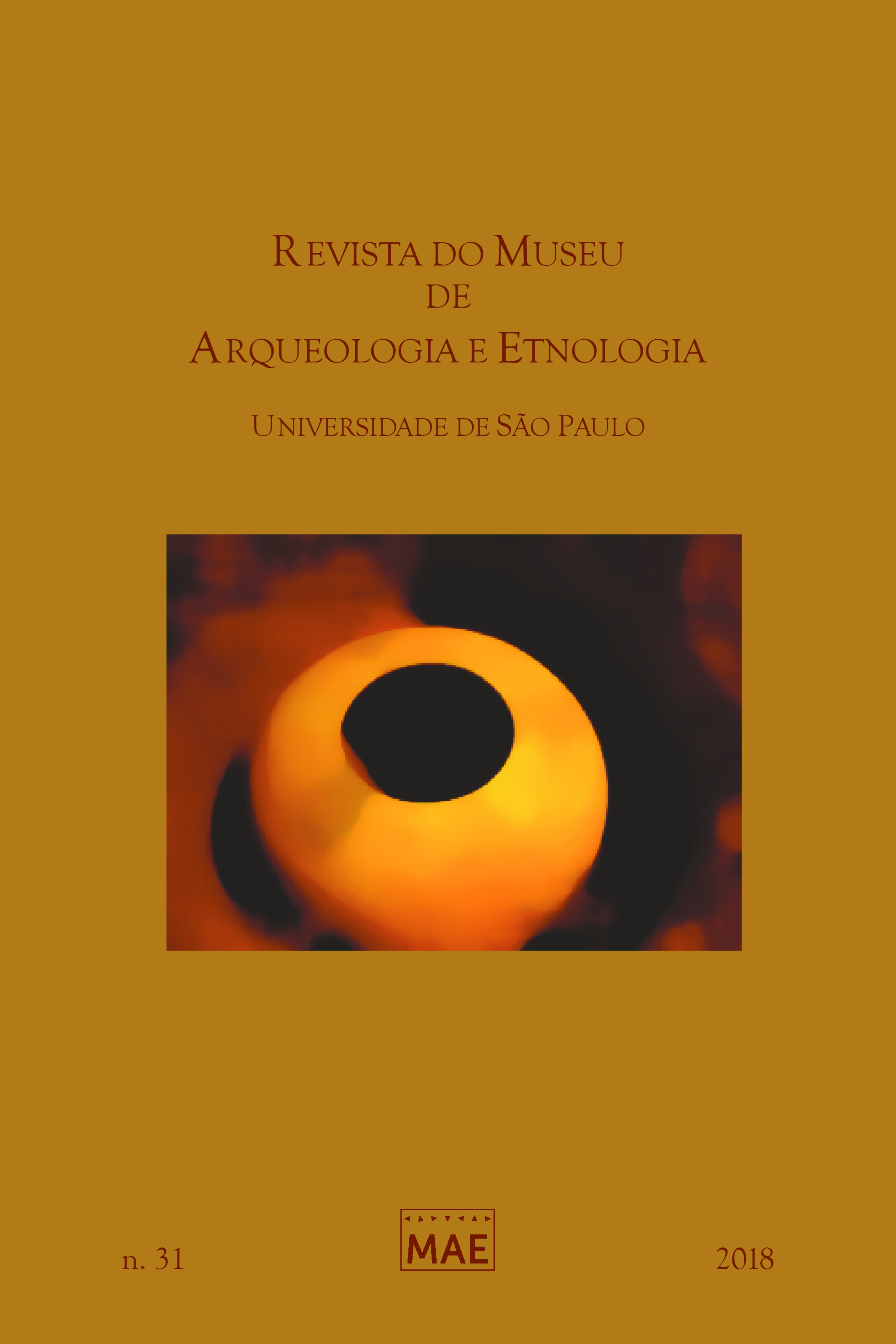The New and the Old World in ancient history, a comparative synthesis within the theoretical debate in the history of urbanism forin archaeology
DOI:
https://doi.org/10.11606/issn.2448-1750.revmae.2018.143730Keywords:
Cities, Urbanization, Neolithic Revolution, New World, Old WorldAbstract
This paper seeks a synthesis of the theoretical review over the so‑called civilizational process, and its cultural development concerning the urban phenomena in the ancient world. It aims to discuss the relationship between Gordon Childe’s qualitative list of Neolithic Revolution’s attributes, and its intrinsic relationship concerning the emergence of the cities and urbanization processes. Thus, we shall compare several models of occupations referred to as urban concerning the ancient Mediterranean, Mesoamerican and Andean worlds, discussing the main views on the historiography of some aspects of urban developmentsduring Andean Formative and Late periods and to the ancient Greek cities.
Downloads
References
Burger, R.1995. Chavín and the origins of the Andean civilization. Thames and Hudson,London.
Burger, R.; Salazar, L.1993. El centrosagrado de chavín de Huantar. In: Townsend, R. (Ed.).La Antigua América: el arte de los parajes sagrados. Art Institute of Chicago, Chicago; Grupo Azbache, Ciudad de México, 265-277.
Canziani, J.2012. Ciudad y territorio en los Andes: contribuciones a la historia del urbanismo prehispánico. 2. ed. Fondo Editorial PUCP, Lima.
Castillo, L.2006. Origem, desenvolvimento e colapso das sociedades mochicas. In: Alva, W. (Ed.).Tesouros do Senhor de Sipán Peru: o esplendor da culturamochica. Stilgraf Gráfica e Editora, São Paulo,125-135.
Childe, G.2004. The Urban Revolution. In: Patterson, T.E.;Orser, C. Foundations of social archaeology.Altamira Press, New York,107-116.
Clastres, P.1982. A sociedade contra o Estado. 2. ed.Livraria Francisco Alves Editora S.A., Rio de Janeiro.
Coulanges, F.2006. A cidade antiga. eBooksBrasil, sem local. Disponível em: <http://bit.ly/32TUapG>. Acesso em: 25/07/2019.
Figueiredo, M. 2014. Política e religião no Tahuantinsuyu Inca: evidências das relações centro x periferia de Cusco na cerâmica arqueológica da Costa Norte peruana. Dissertação de Mestrado. Museu de Arqueologia e Etnologia, Universidade de São Paulo, São Paulo.
Florenzano, M.B. (Coord.).2009. Cidade e território na Grécia antiga:organização do espaço e sociedade. Projeto de pesquisa Labeca, Universidade de São Paulo, São Paulo.
Gat, A.2000. Why city-states existed? Riddles and clues of urbanisation and fortifications. In: Hansen, M.H. (Ed.).A comparative study of six city-State cultures: an investigation conducted by the Copenhagen Polis Centre. Copenhagen Polis Centre, Copenhagen,125-139.
Giersz,M.;Makowsk,K.2014. El fenómeno Wari: tras las huellas de un imperio prehispánico. In: Giersz, M.;Pardo, C. (Eds.).Castillo de Huarmey:el mausoleo imperial Wari. Mali, Lima, 34-67.
Grube, N.2000. The city-statesof the Maya. In: Hansen, M.H. (ed.): A comparative study of thirty city-State cultures: an investigation conducted by the Copenhagen Polis Centre. Copenhagen Polis Centre, Copenhagen, 547-565.
Hansen, M.H.2000. The concept of city-State and city-State culture. In: Hansen, M.H. (Ed.).A comparative study of thirty city-State cultures: an investigation conducted by the Copenhagen Polis Centre.Copenhagen Polis Centre, Copenhagen, 11-34.
Kolb, F.1992. La ciudad en la antigüedad. Grevos, Madrid.
Labeca. 2010. A organização da khóra: a cidade grega diante da sua hinterlândia. Projeto de pesquisa Labeca, Universidade de São Paulo, São Paulo.
Lawrence, D.L.; Low, S.M.1990. The built environment and spatial form. Annual Review of Anthropology 19:453-505. Disponível em: http://bit.ly/2MgogOm. Acesso em: 15/07/2019.
Lind, M.D.2000. Mixtec city-states and Mixtec city-State culture. In: Hansen, M.H. (Ed.).A comparative study of thirty city-State cultures: an investigation conducted by the Copenhagen Polis Centre. Copenhagen Polis Centre, Copenhagen, 567-580.
Lumbreras, L.G.1972. De los orígenes del Estado en el Perú: nueva crónica sobre el viejo Perú. Carlos Milla Batres, Lima.
Morris, C. 1999. La arquitectura del Tahuantinsuyu. In: Franklin Pease, G.Y. (Ed.) Los Incas, arte y símbolos.Banco de Crédito del Perú. Lima, 1-60.
Morris, C. 2013. El palacio, la plaza y la fiesta en el Imperio inca. Fondo Editorial PUCP, Lima.
Moseley, M.1992. The Incas and their ancestors: the archeology of Peru.Thames and Hudson LTD, New York.
Murra, J.V.1975. Formaciones económicas del mundo andino. Instituto de Estudios Peruanos, Lima.
Murra, J.V. 1989. La organización económica del Estado inca. Siglo Veintiuno Editores, México D.F.
Niemeyer, H.G.2000. The early Phoenician city-states on the Mediterranean: archaeological elements for their description. In:Hansen, M.H. (Ed.).A comparative study of thirty city-State cultures: an investigation conducted by the Copenhagen Polis Centre. Copenhagen Polis Centre, Copenhagen, 90-115.
Pozorski, T.;Pozorski,S.1993. Early complex society and ceremonialism on the peruvian north coast. In:Millones, L.;Onuke, Y. (Eds.). El mundo ceremonial Andino. National Museum of Ethnology, Osaka, 45-68.
Rostworowski, M.2000. Estructuras andinas del poder: ideología religiosa y política. Instituto de Estúdios Peruanos, Lima.
Smith, M.E.2010. Forma e significado nas cidades antigas: uma nova abordagem para o planejamento urbano. Disponível em: <http://bit.ly/32X92Un>. Acesso em: 26/07/2019.
Whitley, J.2010. A cidade, o Estado e a pólis. Disponível em: <http://bit.ly/2OhC65x>. Acesso em: 26/07/2019.
Downloads
Published
Issue
Section
License
Copyright (c) 2018 Marcio Luis Bauso de Figueiredo

This work is licensed under a Creative Commons Attribution-NonCommercial-NoDerivatives 4.0 International License.













